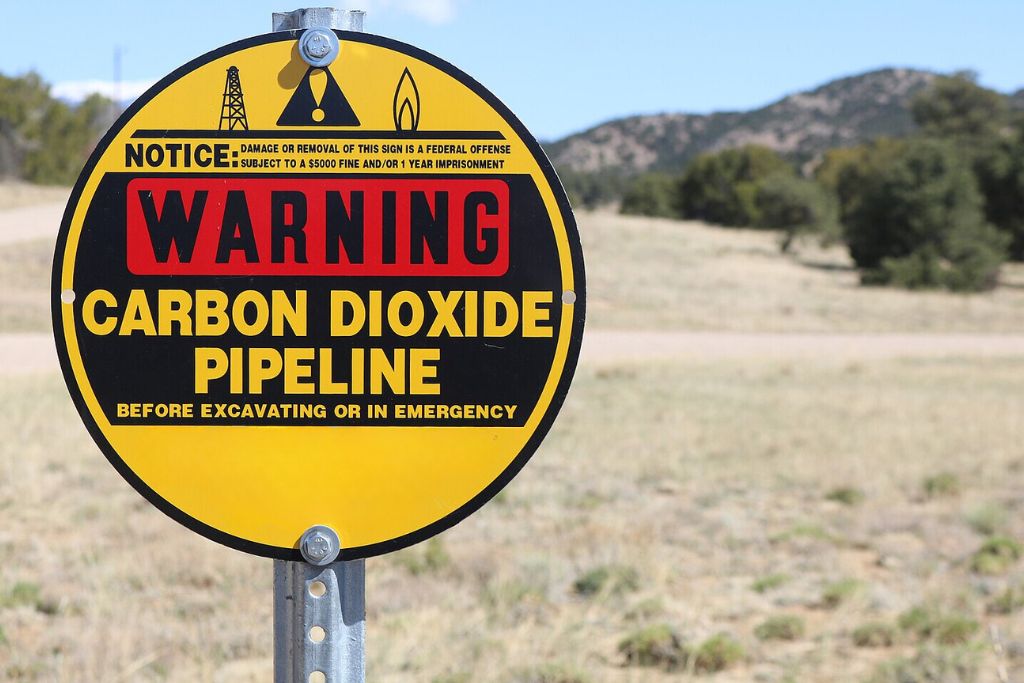New Bill Targets Carbon Dioxide Pipeline Leaks
Legislation introduced by Assemblymember Arambula, with research help from UCLA students, aims to protect Californians from the dangers of transporting captured carbon dioxide.

Guest contributor Jennifer Imm is a J.D. Candidate at UCLA Law (2L)
Last week, Assemblymember Dr. Joaquin Arambula introduced AB 2623, a bill designed to guard California communities against the dangers of transporting carbon dioxide in pipelines. These risks aren’t hypothetical: A leak from a carbon dioxide pipeline already caused serious health harms in Satartia, Mississippi, where 45 people were hospitalized following a pipeline rupture in early 2020. Firsthand accounts of that mass poisoning described a white cloud shooting into the sky, hundreds of people evacuated, and unprepared first responders. Fortunately, nobody died, but an investigation showed deaths would have been likely if the pipeline had burst during the night or if the wind direction had been different. While federal regulators consider changes to their pipeline regulations, the California Legislature should act to keep Californians safe.
You might be familiar with carbon dioxide as a greenhouse gas that contributes to climate change. Or perhaps you know it better as the gas that we breathe out and plants take in. However, you might be surprised to discover that carbon dioxide makes up just 0.04% of the earth’s atmosphere. At higher concentrations, carbon dioxide can be deadly. Because carbon dioxide is denser than air, it sinks, displacing oxygen and causing humans and animals to asphyxiate. And because it is colorless and odorless, a carbon dioxide leak can be difficult to detect without proper monitoring.
Last semester, Stella Gianoukakis, Anirudh Krishna, and I participated in UCLA Law’s California Environmental Legislation and Policy Clinic, where we worked with Assemblymember Arambula’s office to research the impacts of carbon capture, utilization, and sequestration (commonly referred to as CCUS) on California communities. Our research and meetings with stakeholder communities in areas of California where carbon dioxide pipelines are likely to be built—mostly in California’s Central Valley—revealed that the potential for a disaster like the one that took place in Satartia was a primary concern.
CCUS involves capturing carbon dioxide from fossil fuel power plants or directly from the air and either using it or sequestering it deep underground to prevent it from being released back into the atmosphere. Critics of CCUS worry it will delay the transition away from planet-warming fossil fuels, but state analyses like the California Air Resources Board’s Scoping Plan increasingly view CCUS as a potential tool in the toolbox as California strives to meet its greenhouse gas reduction targets. So, California’s plan to reach net zero carbon emissions by the year 2045 calls for the capture of significant amounts of carbon dioxide. Since carbon dioxide is not always captured at the same site where it is utilized or sequestered, CCUS will require the transportation of large quantities of carbon dioxide across the state. Pipelines are the safest and most efficient means of transporting carbon dioxide, but as the disaster in Satartia demonstrated, they still come with significant risks. CCUS projects are already being built in California; if CCUS becomes a growing part of the state’s climate strategy, nearby communities must be protected from resulting health impacts.
You might also be surprised to know that there are currently no state regulations covering pipeline transportation of carbon dioxide in California. There are some federal regulations, but they leave much to be desired. These federal regulations—developed by the Pipeline and Hazardous Materials Safety Administration (PHMSA)—only cover pipeline transportation of carbon dioxide that is in a supercritical state (a highly pressurized and stable liquid) at greater than 90% concentration. The pipeline transportation of liquid or gaseous carbon dioxide or supercritical carbon dioxide at less than 90% concentration remains completely unregulated.
The California Legislature should take action on this issue now. In 2022, the Legislature passed SB 905, which placed a moratorium on transportation of carbon dioxide until the PHMSA regulations are updated. However, it is unclear how protective the new federal regulations will be. California has long been a leader in ensuring the health and safety of its residents by developing regulations that go above and beyond the protections established by the federal government. We see no reason why pipeline transportation of carbon dioxide should be any different.
If passed, AB 2623 would close regulatory loopholes and ensure the safe transportation of carbon dioxide in California. It would:
- Prohibit the pipeline transportation of carbon dioxide in forms and concentrations not currently covered by PHMSA regulations
- Prohibit the transportation of carbon dioxide in pipelines built to transport materials other than carbon dioxide
- Direct the State Fire Marshal (SFM) to develop regulations that establish standards for the design, operation, maintenance, and safety of carbon dioxide pipelines
- Grant SFM the authority to enforce these safety regulations
- Modify the existing moratorium on pipeline transportation of carbon dioxide to remain in place until both the new federal PHMSA regulations and state SFM regulations are in place
AB 2623 will ensure that intrastate transportation of carbon dioxide is done in a manner that minimizes risks to public and environmental health and safety. With proper regulations in place, we can prevent a disaster like the one that took place in Satartia from happening in California. Now that the bill has been introduced, its next stop is a policy committee hearing, likely in March or early April. We’ll be watching the bill closely!






Reader Comments